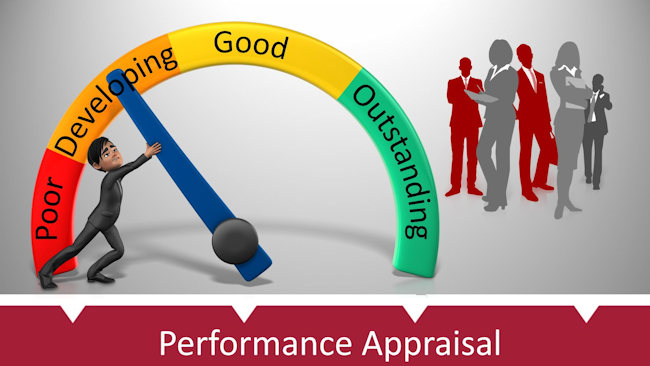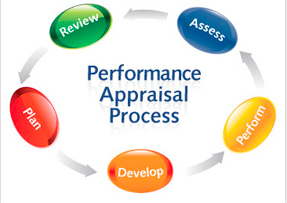
Table of Contents
What is Performance Appraisal?
- A performance appraisal is an ordered evaluation of an employee’s job performance.
- Also recognized as an “annual review,” “performance review,” or “employee appraisal,” a performance appraisal values an employee’s assistance, accomplishments, and progress, or lack thereof.
- Firms use performance appraisals to give employees big-picture opinion on their effort and to explain pay raises and bonuses, along with termination
- Performance appraisal can be done at any given time but is likely to be conducted on annual, semi-annual or quarterly basis.
Objectives of Performance Appraisal
- Performance appraisal helps the organization to decide ways to distribute funds.
- Performance appraisal gives a way for businesses to determine which personnel have contributed the utmost to the company’s progress so that companies can reward their top-performing employees consequently.
- Performance appraisals also help employees and their executives to build a plan for employee improvement through additional training and better accountability
- It also helps to detect weaknesses of the employee so that the employee could work to resolve it.
Different methods/Types of Performance Appraisal
1. Self-assessment: Individuals evaluate their respective job routine and conduct by themselves.
2. Peer assessment: An individual’s performance assessment by his team members.
3. 360-degree feedback assessment: Take account of feedback from an individual, his/her superior and peers.
4. Negotiated appraisal: A firsthand trend uses a facilitator and tries to moderate the confrontational nature of performance assessments by permitting the subject to present first. In addition, it focuses on what the individual is doing right before any criticism is agreed. This arrangement tends to be beneficial during conflicts among assistants and administrators.
Process of Performance Appraisal
- Step 1: Set performance anticipations and principles
- Step 2: Provide systematic feedback
- Step 3: Measure actual performance
- Step 4: Relate actual performance with principles
- Step 5: Deliberate outcomes of appraisal
- Step 6: Crop up with remedial measures

Process of Performance Appraisal should not be inevitably used as an attitude of oppressing weak employees but should instead be used in ensuring that their weaknesses are transformed to become their strengths. Eventually, it helps the organization to attain better results and at the same time raising employees’ profile.
Importance of Performance Appraisal
a) Performance feedback
- Most employees are curious about knowing their current actual performance and how they can do better in the coming future.
- They want this information to increase their performance so that helps in getting promotions and worth pay.
- Proper performance feedback knows how to upgrade the employee’s future performance.
b) Employee training and development decisions
- Performance appraisal facts are used to learn whether an employee needs supplementary training and improvement.
- Insufficiency in performance may be due to insufficient understanding or abilities.
c) Validation of Selection Process
- Performance appraisal is a means of authenticating both internal (promotions and transfers) and external (hiring new employees from outside) sources.
- Organizations spend countless time and money for enrolling and choosing employees.
- Many tools used in the selection process are application blanks, interviews, psychological tests, etc. These tools are used to estimate the applicant’s performance on the job.
- A proper performance appraisal catches the validity of the several selection tools and so the company can keep an eye on appropriate phases for selecting employees in the future.
d) Promotions
- Performance appraisal is a technique of exploring out which employee should be given a promotion.
- Past appraisals, composed with extra background facts, will permit the administration to select suitable individuals for promotion.
e) Transfers
- Performance appraisal is similarly convenient for taking transfer decisions.
- Transfers often include variations in job accountability, and it is vital to realize the employees who can proceed these accountability.
- Such identification of employees who can be transferred is promising through the performance appraisal.
f) Layoff Decisions
- Performance appraisal is a worthy way of taking layoff decisions.
- Employees may be asked to dismiss if the prerequisite rises.
- The weakest performers are the first to be laid off.
- If there is no performance appraisal, then there are probabilities that the finest individuals in the section may be out of a job.
g) Career Development
- Performance appraisal also empowers administrators to tutor and give advice to employees in their career development.
Advantages and Limitations of Performance Appraisal
Advantages
- Documentation: Performance appraisal delivers a manuscript of employee performance over a detailed period of time that could be placed in an employee file.
- Structure: This method makes a structure where a manager can encounter and discuss performance with an employee.
- Feedback: Employees want feedback, and performance appraisal permits supervisor a chance to provide employee with feedback regarding their performance and talk over how well the employee goals were proficient.
- Clarify expectations: Employees need to realize what is expected from them and performance appraisal practice permits a manager to explain hopes and debate concerns with their employee.
- Motivation: The process of performance appraisal motivates employees by gratifying them with a merit increase and an amount of inclusive reimbursement policy.
Limitations
- Generates Negative Experience:
- If not done factual, performance appraisal can generate an adverse experience for the staffs.
- Time Consuming:
- Performance appraisals are very time consuming and can be overpowering to directors with numerous employees
- Natural Biases:
- Human assessment is subject to natural biases that effect in rater miscalculations.
- Supervisors need to recognize these biases to exclude them from the process.
- Waste of Time:
- The whole process can be a waste of time if not done correctly.
- Stressful Workstation:
- Performance appraisals can generate stressful work settings for both employees and managers.
- Appropriate training can help to lessen the stress involved in the progression.
References and For More Information:
https://thethrivingsmallbusiness.com/advantages-and-disadvantages-of-performance-appraisals/
https://kalyan-city.blogspot.com/2011/05/importance-of-performance-appraisal.html
https://www.investopedia.com/what-is-a-performance-appraisal-4586834
https://www.marketing91.com/process-of-performance-appraisal/
http://www.ephlux.com/performance-appraisal-2
https://www.vskills.in/certification/blog/performance-appraisal-tool-of-performance-evaluation/